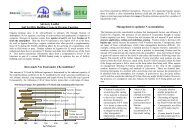Green Manures booklet - Institute of Organic Training and Advice
Green Manures booklet - Institute of Organic Training and Advice
Green Manures booklet - Institute of Organic Training and Advice
Create successful ePaper yourself
Turn your PDF publications into a flip-book with our unique Google optimized e-Paper software.
GRASSES<br />
Perennial ryegrass (Lolium perenne)<br />
Suitability:<br />
L (WG)<br />
pH range preferred:<br />
6.0-7.0<br />
Height:<br />
30-60 cm (if uncut)<br />
Frost tolerance:<br />
Good<br />
The use <strong>of</strong> green manures<br />
Perennial ryegrass establishes rapidly <strong>and</strong> will survive for<br />
3-4 years. It will thrive on fertile soil, establishing deep<br />
<strong>and</strong> dense fibrous root systems but on poor or drought<br />
prone soil other grasses, such as cocksfoot may be more<br />
suitable. Typical annual dry matter production is 15 t/ha.<br />
Ryegrass is most commonly used in a mixture with<br />
various clover species – it may be established by being<br />
undersown in a cereal crop. Its high sugar content <strong>and</strong><br />
digestibility make it particularly suitable for silage<br />
production.<br />
There are many varieties <strong>of</strong> ryegrasses which are divided<br />
into early, intermediate <strong>and</strong> late groups. Early varieties<br />
such as AberTorch, Donard <strong>and</strong> Moy will provide good<br />
early growth <strong>and</strong> head in mid May. Intermediate varieties<br />
include AberDart <strong>and</strong> AberGold <strong>and</strong> later varieties such as<br />
AberCraigs will head in mid June.<br />
Annual ryegrass (Lolium multiflorum)<br />
Annual ryegrass (<strong>of</strong>ten known as Westerwolds ryegrass) is useful where rapid production is needed within 3 –6<br />
months <strong>of</strong> sowing. When sown in the summer or spring they will flower in the same season <strong>and</strong> not persist over<br />
winter. In mild climates they can be sown in autumn to provide early spring growth.<br />
Italian ryegrass (Lolium multiflorum)<br />
Suitability:<br />
L (WG)<br />
pH range preferred:<br />
6.0-8.0<br />
Height:<br />
25-70 cm (if uncut)<br />
Frost tolerance:<br />
Moderate<br />
Annual dry matter:<br />
16 t/ha<br />
Unlike annual ryegrass, Italian ryegrass is a biennual not<br />
flowering until the second season. It can be used for short<br />
term leys <strong>of</strong> up to three years. They produce more early<br />
season growth than perennial ryegrass but midseason<br />
growth tends to be stemmy. Frost tolerance is not as good<br />
as perennial ryegrass <strong>and</strong> they are also susceptible to<br />
drought. Diploid varieties such as Adin <strong>and</strong> Alamo are<br />
more suited to wet environments <strong>and</strong> under these<br />
conditions will outyield tetraploid varieties in the second<br />
year. Tetraploid varieties such as Danergo <strong>and</strong> Fabio will<br />
produce higher yields in the first year than diploid<br />
varieties. Their drought tolerance <strong>and</strong> cold tolerance is<br />
better than diploid varieties.<br />
Hybrids <strong>of</strong> Perennial <strong>and</strong> Italian ryegrasses<br />
Hybrid ryegrasses possess some <strong>of</strong> the characteristics <strong>of</strong> both types, having the early season growth <strong>of</strong> Italian<br />
ryegrass <strong>and</strong> the sward density <strong>of</strong> perennial ryegrass. Varieties such as AberExcel are closer to the characteristics<br />
<strong>of</strong> Italian ryegrass whereas AberStorm <strong>and</strong> Citeliac are closer to perennial ryegrass in type.<br />
10




